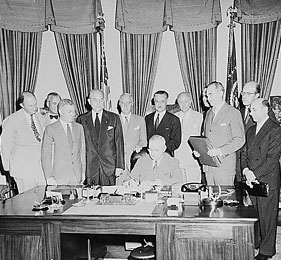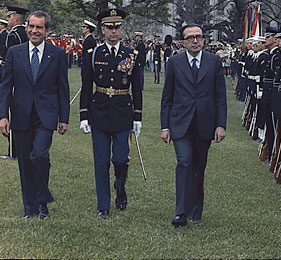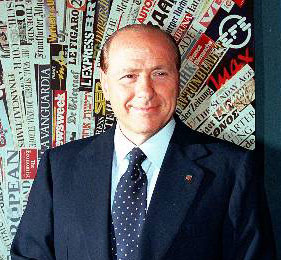The History of Italy’s Many Governments
After two decades of rule by Benito Mussolini and his Fascist regime, Italians found themselves wary of power being concentrated in the hands of one man. As a consequence, laws established in the aftermath of World War II encourage consensus and coalitions; many players and factors can bring down a government. In fact, the average life span of post-war governments is slightly than less one year. Recent changes in election laws have diminished the influence of smaller parties, but the system remains one that strives to value teamwork over the cult of personality.
1945 – 1958: Fascisim, War, and a Nation Rebuilt

Enticed by the potential of territorial rewards and no longer a part of the Triple Alliance (whose dominant powers were Germany and Austria-Hungary), Italy joined the side of the Allied forces during World War I. Yet after the war ended and the spoils were divided, Italy was left with less than had been promised.
Social and political unrest followed and, with it, came the rise of the Fascist party, led by Benito Mussolini. In 1922, with the support of King Victor Emanuel III, Mussolini became Italy’s premier. During the 1930s, Mussolini sought to expand Italian power, seizing Ethiopia and Albania and joining forces with Hitler’s Nazi Germany. In 1943, following the Allied invasion of Italy, Mussolini was overthrown and jailed, only to be freed by Nazi commandos. In late April 1945, days before the end of World War II, Mussolini was captured and executed by Italian forces, his corpse hung upside-down on display in Milan. Once profoundly popular, his war-mongering left him the most hated man in Italy.
After World War II, the Italian monarchy was on its last legs. The king’s support of Mussolini had irrevocably undermined the populace’s support for a monarchy. That year, through a plebiscite, the country voted to become a republic. A new constitution was adopted and, in 1946, the nation’s first legislative elections were held. The Italian parliament was divided into two houses — a lower house, the Chamber of Deputies, and an upper house, the Senate. The members of the Chamber of Deputies were determined through proportional representation. The composition of the Senate was determined through a more complicated process that, in practice, amounted to proportional representation.
The three major political parties that emerged in the early years of the Italian republic were the Christian Democrats — by far the majority — and the Italian Socialist and Communist parties. Alcide De Gasperi, a Christian Democrat, became the republic’s first prime minister, a position he would hold from 1945 to 1953, through eight successive coalition governments. During this period, Italy increasingly aligned itself with the post-war Western powers: In 1949 the nation joined the North Atlantic Treaty Organization and in 1958 joined the European Economic Community (today, the European Union).
1959 – 1992: An Era of Center-Left Coalitions
The next decades of politics in Italy were characterized by frequent changes in premiers and administrations, factional struggles between the country’s political parties, and the prominence of the Christian Democrat party. After Soviet leader Nikita Khrushchev’s acknowledgement, in 1956, of the brutal atrocities of Joseph Stalin’s regime, the Communist Party began to lose ground in Italy. In 1958, Amintore Fanfani was elected to head a coalition of Christian Democrats and centrist Socialists, leaving the Communists relatively marginalized in the years to come.
Though Italy’s rise to become a strong manufacturing nation brought a measure of prosperity to the nation during the 1950s, the 1960s and 1970s witnessed an era of social upheaval in the country. During this period, a series of short-lived coalition governments struggled to deal with unemployment, inflation, and rising national debt. Though Italy’s political parties were becoming polarized, the mid-1960s saw a coalition form under the Christian Democrat Aldo Moro in order to address the nation’s economic downturn. However, large student demonstrations and labor strikes during the “hot autumn” of 1969 revealed the growing sense of disharmony at the base of Italian society. Public support for left-leaning ideologies rose during the early 1970s as a spate of political violence joined Italy’s continuing economic woes. This violence culminated in 1978 with the kidnapping and murder of Moro, the former prime minister, by the left-wing extremist group the Red Brigades.
The fractures in Italy’s voting public eventually revealed a weakness in the Christian Democrats’ political dominance. In 1981, the Republican Giovanni Spadolini became Italy’s first premier since the war who was not a Christian Democrat. The Socialist Bettino Craxi soon followed him in 1983. At almost three consecutive years, Craxi’s government lasted longer than that of any post-war leader up to that time. In 1991, as European communism was collapsing, the Italian Communist party renamed itself the Party of the Democratic Left in an effort to soften its perception in the public eye. In a similar move, the Socialists became the Party of Socialist Unity. But in the April 1992 elections, all of the major parties received lower returns as voters showed their disapproval both for the government’s policies as well as the widespread corruption that was being revealed within the system.
1993 -2003: Electoral Reform and the “Second Republic”
The early 1990s were a period of turmoil and reform in Italian politics. In 1992, a sweeping judicial investigation entitled “Clean Hands” was begun to root out corruption in Italian politics. Operation Clean Hands soon uncovered the “Bribesville” scandal, which extended widely throughout Italian politics and would eventually implicate five former prime ministers and result in more than 1,000 criminal indictments. A similar investigation of high-ranking Mafia connections in the government resulted in the arrest of the Sicilian boss Salvatore Riina in 1993. The reputations of the Christian Democratic and Socialist parties were severely damaged by instability and corruption. In April 1993, an important electoral referendum was passed that sought to reduce the influence of minor parties on the nation’s political structure. The new voting law also served to hasten the decline of Italy’s long-established parties.
The 1994 elections marked a major change in Italian politics. In an effort to refashion its image, the Christian Democratic Party split into two factions early in the year leaving an opening in Italy’s political power structure. The new center-right Forza Italia (literally “Force, Italy,” but also meaning “Go, Italy!”) party led by media mogul Silvio Berlusconi swept into office in March buoyed by its visions of popular government. But Berlusconi’s own business transactions were soon under investigation and to many his media empire represented a clear conflict of interest. He was forced to step down in December with the withdrawal of the support of the powerful Lega Nord (Northern League) from his coalition.
In April 1996 the broad, center-left “Olive Tree” coalition under Romano Prodi came to power and ushered in Italy’s first leftist government since 1946. The Olive Tree government established a relatively long period of stability until its Communist allies withdrew their support late in 1998. After another period of short-lived governments, the new “House of Freedoms” cartel carried the 2000 regional elections. Prominent in the House of Freedoms coalition were the far-rightist Alleanza Nazionale (National Alliance) party and Silvio Berlusconi’s Forza Italia movement. With the House of Freedoms endorsement, former Prime Minister Silvio Berlusconi was once again elected to lead Italy in 2001. Berlusconi brought with him new pledges for economic growth, political stability, and a promise to make Italy a republic of the people.


